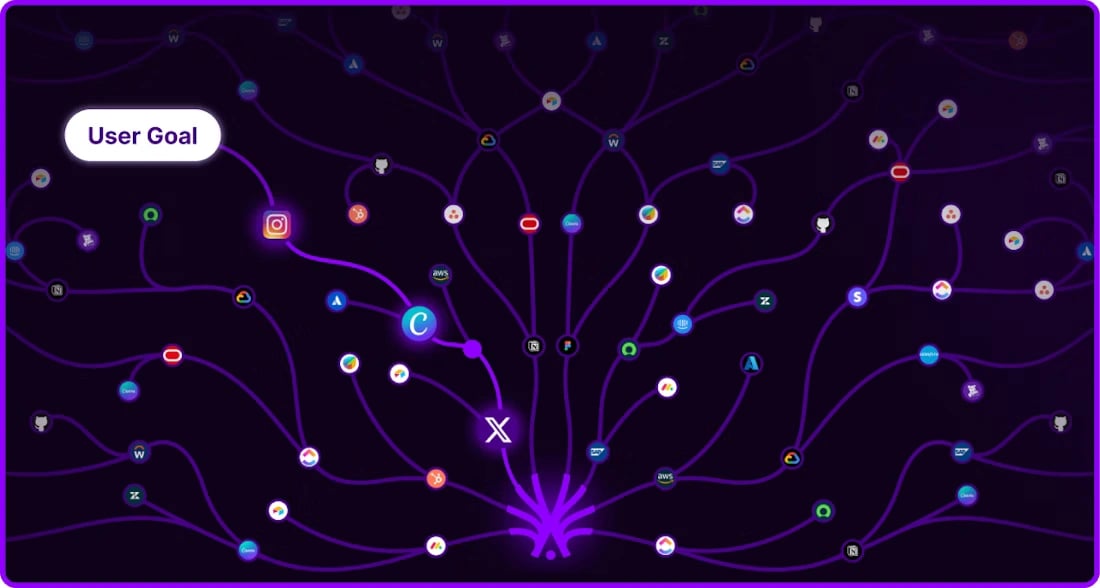订阅 wiki
Share wiki
Bookmark
ActionModel
ActionModel
ActionModel 是一个去中心化的人工智能项目,旨在开发一个社区拥有的“大型行动模型”(LAM)。该平台旨在通过与图形用户界面(GUI)交互来执行数字任务,目标是通过浏览器扩展补偿贡献训练数据的用户。 [2]
概述
ActionModel正在被开发为大型科技公司控制的中心化人工智能系统的去中心化替代方案。该项目的基本概念是,提供数据来训练AI模型的人应该分享该模型创造的价值。该系统旨在通过观察用户交互来学习如何执行基于计算机的任务,这些交互通过浏览器扩展收集。这种方法允许模型在各种网站和应用程序上自动执行任务,而无需访问其应用程序编程接口(API)。
该项目的长期愿景是创建一个由其贡献者和用户社区拥有和管理的“互联网自动化层”。这种集体所有权模式通过平台的原生代币$LAM来实现。该代币旨在作为访问生态系统内服务的实用工具和治理工具,允许持有者参与有关平台开发和未来方向的关键决策。生态系统的结构旨在创建一个循环,用户数据贡献改进AI,进而实现更强大的自动化工具,供社区使用。
产品
ActionModel生态系统围绕两个核心产品构建,专为数据贡献和任务自动化而设计。
ActionModel浏览器扩展
ActionModel浏览器扩展是ActionModel生态系统中数据收集的主要工具。它在用户Web浏览器的后台运行,捕获匿名交互数据,用于训练大型行动模型(LAM)。该扩展包括两种数据贡献模式:被动训练,自动收集浏览交互数据以构建广泛的数据集;主动训练,允许用户有意识地记录特定的工作流程或任务,以生成更高质量的标记数据,用于复杂的、多步骤的过程。参与者因其贡献而获得代币,反映了一种社区驱动的AI训练方法。该扩展集成了隐私保护,让用户可以控制共享信息,同时排除敏感数据,并且设计简单,易于安装和后台操作。 [2] [1]
Actionist
Actionist是ActionModel的旗舰桌面应用程序,旨在自动执行基于计算机的任务,而无需编码知识。它通过控制用户的鼠标、键盘和屏幕来运行,使其能够执行类似于人类用户的数字活动。该平台支持创建AI代理,这些代理可以按计划执行工作流程,并支持内存、历史记录跟踪以及与外部工具的集成。 [10]
核心功能
- 代理和工作流程: 为营销、销售、人力资源和运营等部门创建专门的AI代理。工作流程构建或导入代理可以精确执行的自动化任务。 [4]
- 日历: 安排自动化在指定时间运行,类似于轮班管理。 [5]
- 内存: 代理内存是ActionModel中的一项功能,使AI代理能够随着时间的推移保留信息和上下文。它充当持久的知识库,允许自动化根据先前的交互、用户偏好和跨平台关系进行调整。此功能将代理从执行孤立的任务转变为执行由累积知识驱动的、具有上下文意识的过程。 [6]
- 历史记录: 代理历史记录是ActionModel中的一项监控和透明度功能,用于记录和跟踪AI代理执行的每个操作。它提供完整的审计跟踪,允许用户审查、分析和验证自动化工作流程。该系统提供对决策过程的详细可见性,支持调试、性能评估和合规性管理。 [7]
- 工具集成: ActionModel中的工具集成允许AI代理访问和使用各种数字工具来执行复杂的自动化任务。这些工具包括Web抓取、API交互、文件管理和计算机视觉等功能。通过将代理与外部工具和系统连接,该功能可以在不同的平台上实现更通用和高效的任务执行。 [8]
用例
- 个人用途: 该平台旨在帮助个人自动执行日常任务,例如通过安排帖子来管理社交媒体帐户、计划和预订旅行安排、自动填写在线求职申请、监控电子商务网站的价格变化以及整理电子邮件收件箱。
- 商业用途: 对于商业应用,ActionModel旨在处理重复性任务(如数据输入)、执行跨越不同软件平台而无需API的复杂多步骤流程,以及安排重复性运营任务以提高效率。
- 企业用途: 在企业层面,该平台的Cloud VPC模式旨在允许部署整个AI代理群,这些代理可以持续运行以执行大规模自动化,例如数据处理、系统监控和质量保证测试。
架构
ActionModel的技术架构基于两个专有概念,这些概念控制着AI如何学习和执行任务。
行动循环
行动循环是LAM用于执行任何给定任务的基本循环过程。此过程包含四个不同的步骤,这些步骤会重复执行,直到达到最终目标:
- 查看屏幕: AI首先捕获并分析屏幕的当前状态,以了解上下文,识别可用的交互元素(如按钮和表单字段),并评估应用程序的整体布局。
- 决定: 根据其训练数据和当前目标,模型确定要采取的下一个最佳操作。这可能是单击特定按钮、在字段中键入文本或滚动页面。
- 行动: AI通过直接控制鼠标光标或键盘来执行所选的GUI操作。
- 循环: 执行操作后,系统通过观察屏幕上的变化来验证结果,然后从“查看屏幕”步骤开始再次循环,继续此过程直到任务完成。 [10]
行动树

行动树是一个概念框架,表示网站和应用程序数字环境中所有可能的用户操作和工作流程的综合地图。此“地图”是通过从用户贡献收集的数据构建并不断扩展的,这些数据称为“行动分支”。每个贡献都会在树中添加新路径或优化现有路径。随着越来越多的用户从各种应用程序贡献数据,行动树会变得更大、更详细,这反过来又使LAM能够以更高的精度和可靠性导航和执行越来越广泛的复杂任务。 [12] [13]
代币经济学
ActionModel生态系统的原生实用程序和治理代币被指定为$LAM。该代币旨在成为平台经济模型、价值分配和去中心化治理结构不可或缺的一部分。
分配
- 创建者分配: 33%
- 销毁: 34%
- 生态系统: 33% [2]
代币实用程序
- 行动燃料: LAM通过Actionist应用程序执行的每个操作都旨在消耗少量$LAM代币,从而产生与平台使用相关的持续需求来源。
- 训练奖励: 通过运行浏览器扩展来贡献数据以训练模型的用户将因其参与而获得$LAM代币奖励。
- 市场收入: 在平台的市场上构建和销售自动化工作流程的创建者将以$LAM代币赚取收入。
- 治理权: 持有$LAM旨在授予用户对与平台开发、资金管理和整体治理相关的关键提案的投票权。
- 销毁机制: 代币经济学模型包括通货紧缩的销毁机制。计划将用作“行动燃料”的一部分$LAM代币永久从流通中移除,这旨在随着时间的推移减少总供应量。 [3] [12]
治理
该项目的目标是实施一种去中心化治理模型,其中$LAM代币的持有者可以积极参与决策过程。这种结构旨在让用户和数据贡献者社区直接影响ActionModel平台的未来方向,包括协议升级和功能开发。
发现错误了吗?
